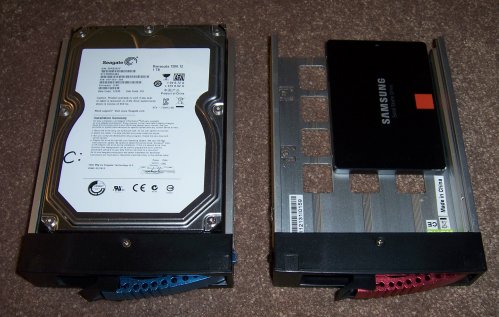
Having had a certain amount of trouble with keeping multiple OS images on a single drive, I’ve been looking for a reliable way to pop a bootable SATA hard drive into my quadcore. The goal is to have one OS per drive. Drives smaller than 128GB are fairly cheap, and drives 80GB or smaller are dirt cheap. The challenge is purely mechanical, and I think I’ve got a line on it: the IStarUSA T-7M1 mobile rack. It can be had in a number of places, including Newegg and Amazon. About $35. It’s a full-size SATA drive holder that contains a removable sled to which the drive itself is bolted. The sleds themselves are available separately, at about $15-$20 each. They come in several different colors, including silver, blue, black, and red.
In use, the drive can be spun down while the machine is operating, or you can wait until you power down the machine as a whole before popping a drive and tucking a new one in. (That’s what I do. The Windows feature allowing hot-swapping of the drives slows down drive throughput, or so I’ve read.) I’m currently in the process of building a new Windows image on a Samsung 120GB SSD, and being able to swap sleds between my current image and the new image means I can take my time and do it right.
The only serious question about this is how many times the SATA leaf connectors on the backs of SATA drives can be cycled without compromising them. The SATA spec says 50 times, which does seem low but is probably conservative. The truth is that I don’t think of these as bigger thumb drives and won’t be yanking them anywhere near as often. Although I occasionally boot into Linux on this machine, I have a dedicated multiboot Linux box in my shop. I doubt I’ve gone into Linux here since last fall. Also, I have a case that contains two toaster-style SATA slots on top, and I’ve been using them for monthly backups since last summer without incident. A backchannel correspondent who swaps files using a BlacX case like mine says the danger is overrated. He’s had drives in and out of various docks well over 50 times and the drives still work perfectly. Even if I plug drives in monthly, I still get 5 years of backups without going beyond the spec. That’s more than good enough for me.
I’ve wanted to try an SSD for a couple of years. My reaction so far is that software comes in quite a bit faster from an SSD, especially the first time after boot-up. And with one less motor spinning, the machine is mildly but noticeably quieter. (I don’t have an outboard graphics card, and the case stays quite cool with only a single 120mm fan running.)
I’ve got a couple more evenings of configuration to do on the SSD image, but after I’ve been using it awhile I’ll post my impressions here. So far, the sledding has been fine.











I’ve been using Addonics’ drive cartridge system (http://www.addonics.com/products/ddcssas.php) for a few years and haven’t had any trouble.